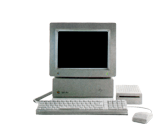Game Interpreters Part II: An easier adventure to accomplish?
OK, so creating a runtime environment for Lucas Arts adventure games for the IIGS is no walk in the park. How about something that's hopefully easier, but still for the truly adventurous at heart?
The IIGS excels at text/graphic adventures: Tass Times in Tonetown, Dream Zone and the ICOM series to name a few. We've also got an interpreter that can play all the classic Infocom adventures.
But remember the ‘G' in Apple IIGS stands for ‘Graphics'? And Infocom weren't the only game in town when it came to determining your fate with a text parser. Enter, perhaps, Magnetic Scrolls' text/graphic adventures: The Pawn, The Guild of Thieves, Jinxter, Corruption, Fish, Myth and Wonderland.
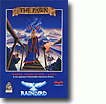
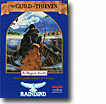
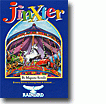
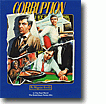
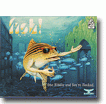
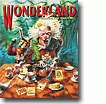
Magnetic Scrolls was a U.K. based company in the 80s that released six well-regarded text/graphic adventures for the Atari ST, Amiga, Spectrum, MS-DOS and even some for the 8-bit Apple II (Myth is not included in the six, given that it was not a public release). And just like the Lucas Arts adventures, the fans still want the opportunity to relive these classics on platforms other than those listed above. So they've created an interpreter, that's portable having been written in C. Also, while very convenient, though technically abandonware (which means nothing to protect your arse legally), all of the games are downloadable in complete packages for use with the ‘Magnetic' interpreter - on the same page you download the interpreter!
The graphics in Magnetic Scrolls games became most detailed with the Atari ST version: a feat the IIGS can match given these are 4-bit graphics.
So things are looking good: a portable interpreter, requiring little processing horsepower to run, with graphics able to be displayed on the IIGS without conversion and the games are easily obtained (although I strongly encourage you to buy any version of these games on eBay to make it legal at your end). The IIGS, despite its limitations, can marry text and graphics with élan...if anyone is willing to give the coding a shot to see it happen that is, as I can't program my way out of a brown paper bag.
For my part however, I've created some screen shot mock-ups, which should hopefully help the planning required to implement the Magnetic interpreter to the IIGS.
As a starting point, I decided to stick to the standard Apple user interface in 320 by 200 graphics mode. This should have the advantage that a) programmers can take advantage of the Toolbox to take care of text display and scrolling, pull down menus, open and save dialogue boxes, etc and b) in theory, you can continue using desk accessories and perhaps even use the Manager so you can switch back and forth between that all important spreadsheet and enjoying some time with Alice in Wonderland.
One aspect of Magnetic Scrolls games that I find bizarre is that the sizes of the graphics vary from scene to scene. This may have made it easier for the artist to complete all the graphics on time and fit them all on a floppy, but it also creates the problem of balancing a consistent interface and wasting valuable screen real estate.
Starting with Wonderland's opening graphic, which is the largest single image I've seen in a MS game yet (mind you, I haven't played through to the end of ANY of them) but I'm going to guess, foolishly, that the graphics don't get any bigger than this.
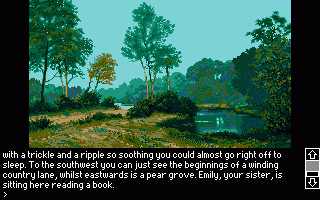
The landscape image above is 262 pixels wide by 148 pixels high on the 320 by 200 'canvas'. Positioning the image from the very top and centring from the horizontal axis allows just enough space for that much needed text with which players will interact with. Copying and pasting text from the Mac version of Magnetic into the Hermes text editor on the IIGS, I could simulate the appearance of text on the IIGS. I chose the font ‘Swift', which you can find on the pre-installed System 6.0.1 hard drive image, as a substitute for the default Shaston font. Swift is fantastic - it saves a good deal of horizontal space compared to Shaston, yet remains very easy to read. You can see it allows up to four lines of text and an additional line for the parser. Just enough so you won't always miss that opening line when entering a new scene, minimising the amount of times you'll need to scroll back to catch all the details of entering new rooms.
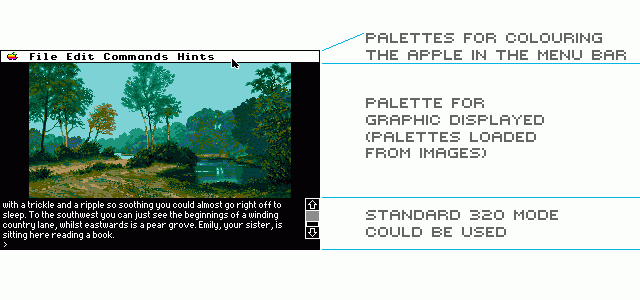
But that leaves no room for the standard menu bar above? Wrong! If we can use the same trick that Becky Heineman employed with the GS/OS versions of Bard's Tale I and II, as well as Dragon Wars, the menu bar appears over the top of the game's graphics only when the mouse cursor ventures to the top of the screen. If it's too difficult to code the menu bar in this way, it can sit over the image. A few rows of pixels won't really matter, as the real attention to detail is found in each game's text, not the graphics. Also, note where the allocation of colour palettes would be placed for display on a IIGS.
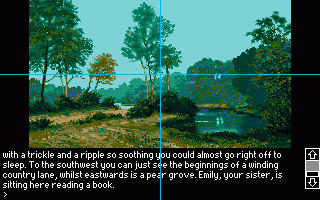
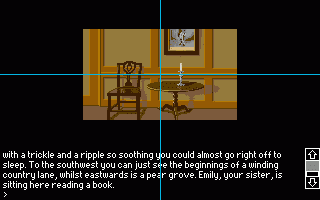
Getting back to the graphic on display during the game - all other graphics will use the absolute centre point of the largest graphic (opening Wonderland image), and then use this as their centre point when being displayed. See the examples above that help illustrate the point.
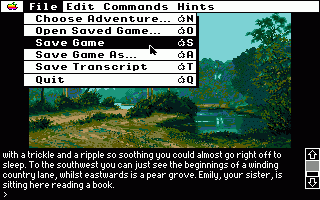
I've mocked up some samples of the pull down menus, with consideration given to clear communication and choosing appropriate keyboard shortcuts. In context, ‘Adventure', as seen in ‘Choose Adventure...', refers to the Magnetic Scrolls game currently being played, making a clear distinction between that and ‘Open Saved Game...' which refers to restoring your last position in the adventure that you saved. ‘Save Transcript' will save all the text so far displayed to a new text file, a common feature with interpreters and damn handy when making these types of screen shots!
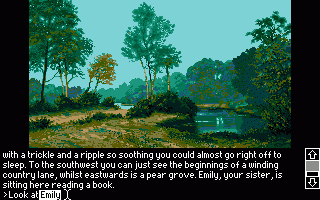
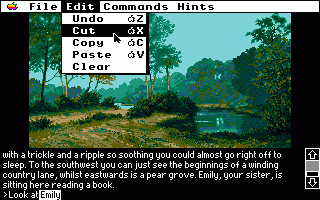
If it were feasible to support, it would be great to be able to select text that you enter into the parser. This would enable the player to copy and paste verbs or nouns that may require repetition to try your answers to puzzles. All Edit menu commands would of course use standardised keyboard shortcuts.
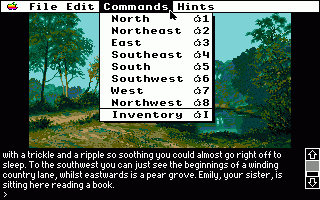
Not found in the OS X version of Magnetic at least, a 'Commands' menu would enter commonly used actions into the parser automatically, saving you the trouble of typing them. I've given keyboard shortcuts to moving in different directions of the compass point, inspired by the directions that can be given by the face of the clock (although you can't have a shortcut for command-12 to mean the same as north, so I've rounded it to 1). Last but not least, checking your inventory with command-i, might provide that inspiration you need to solve that puzzle.
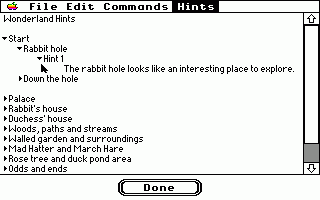
Some Magnetic Scrolls games include hints that can provide additional puzzle-solving inspiration. I've quickly mocked up how it might look on the IIGS, based on the OS X version, but I don't know if this hierarchical system would work. It may perhaps with the 'Hierarchic' permanent initialisation file from Seven Hills Software, which is free.
Some additional points: Wonderland includes some basic frame based animation for some scenes. It also includes image scrolling. Again, I feel both are potentially capable to realise on the IIGS, as we're not talking 60 frames per second type animation.
So anyone willing to take the plunge programming this for the IIGS, a true adventurer? Anyone? Anyone? Bueller?
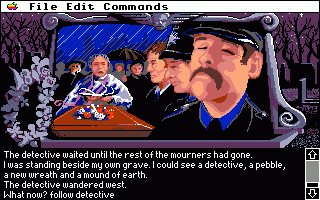
If all goes well, it might not end there for ‘new' text/graphic adventures appearing on the IIGS. Level 9, another UK company respected for its text adventures, produced many games in the 80s, the mock-up above for the game 'Scapeghost', including those with graphics for the Atari ST. And just like Magnetic Scrolls games, a portable platform agnostic interpreter has also been written for these Level 9 games...
